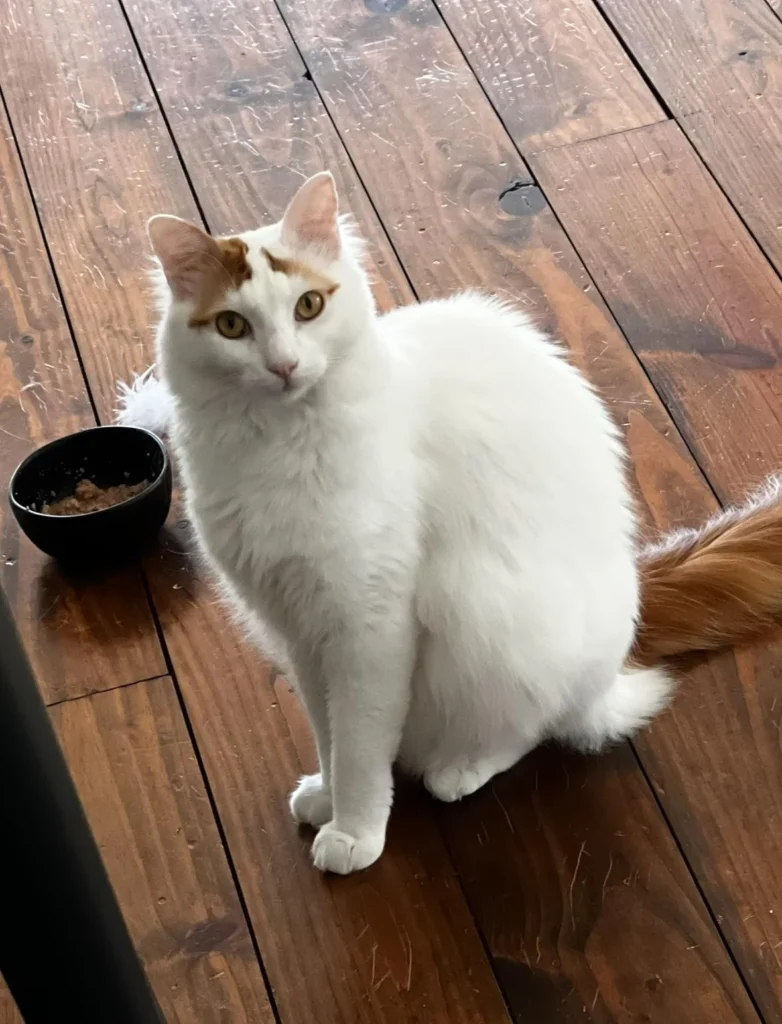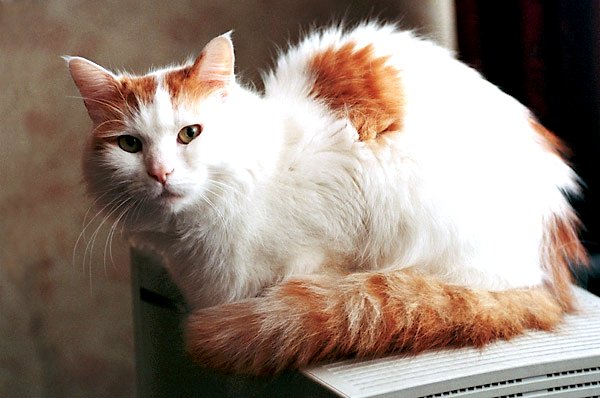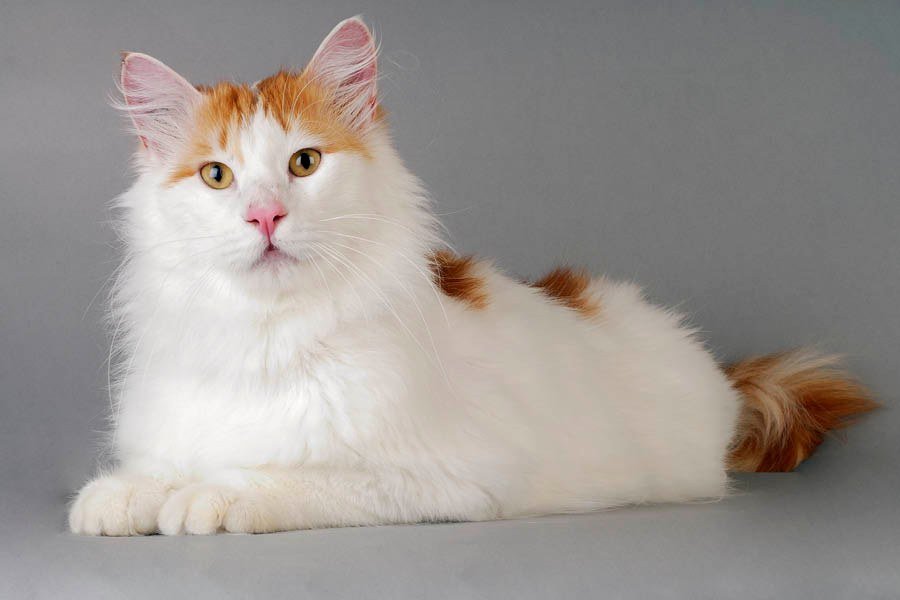Turkish Van
The Turkish Van cat is a breed renowned for its striking appearance and captivating personality. Characterized by a semi-longhair coat that is predominantly white, these felines often display colorful markings, typically found on their head and tail. This unique color pattern is one of the breed’s most distinguishing features, making them easily recognizable among cat enthusiasts. The Turkish Van is not only appreciated for its aesthetics but also for its energetic and playful nature, traits that endear it to households around the world.

Originating from the Lake Van region in Turkey, the Turkish Van’s history is steeped in rich cultural significance. According to historical accounts, this breed has been a part of the area for thousands of years, often associated with local legends and myths. Interestingly, the Turkish Van is known for its affinity for water, a rare characteristic in cats, and is believed to have evolved in a region where water was a crucial element for survival. The breed’s relationship with water is as unique as its appearance, leading to an intriguing depth in its behavioral traits.
The journey of the Turkish Van to international recognition began in the 20th century, with efforts made to preserve the breed’s lineage. Through selective breeding and significant advocacy, the Turkish Van has been acknowledged as a distinct breed by various cat registries. Its distinct characteristics, including vivid blue or amber eyes, further contribute to its appeal. Understanding the history and features of the Turkish Van lays the groundwork for appreciating its significance in both pet ownership and feline history, underscoring its unique position as a beloved companion and cultural icon.

Personality
The Turkish Van cat is a breed renowned for its distinctive personality traits, which set it apart in the feline world. One of the most notable characteristics of this breed is its affectionateness. Turkish Vans are often seen seeking companionship from their human families, forming strong bonds that lead to a loyal and engaging relationship. This attachment is not limited to a specific individual; rather, they possess a sociable nature that allows them to interact positively with all members of a household, including children and other pets.
In addition to being loving and social, the Turkish Van is regarded as an energetic and playful breed. Owners frequently describe their Vans as active participants in family life, showcasing a playful spirit that thrives in an interactive environment. They enjoy engaging in various forms of play, from chasing after toys to exploring new spaces within the home. Their playful demeanor not only provides entertainment but also encourages them to stay physically fit and mentally stimulated.
Curiosity is another defining trait of the Turkish Van cat. They are known for investigating their surroundings, demonstrating a keen interest in everyday activities. Whether it’s watching their owners from a window perch or exploring new objects within the home, their inquisitive nature keeps them alert and engaged. Moreover, Turkish Vans are recognized for their intelligence; they are quick learners that often enjoy the challenge of puzzle toys or training sessions, which can further enhance their bond with their families.
Interestingly, the Turkish Van cat has a unique affinity for water, a rarity among cat breeds. Many Turkish Vans display a fascination with swimming or playing in water, which adds yet another layer to their distinctive personality. This trait is reflective of their adventurous spirit and highlights their differences in behavior compared to more typical domestic cats.
Origins
The Turkish Van cat, with its striking appearance and playful personality, has made a notable mark in various facets of popular culture. This breed is frequently depicted in literature, films, and social media, capturing the hearts of cat enthusiasts and casual observers alike. The unique attributes of the Turkish Van, such as their distinct color patterns, particularly the “Van pattern” which includes a predominantly white coat with colored markings on the head and tail, set them apart from other feline breeds. Their energetic and affectionate demeanor only adds to their allure, making them compelling subjects for artistic representation.

In literature, the Turkish Van cat has been featured in various children’s books and stories where its playful nature and water-loving tendencies are often highlighted. These stories frequently portray the breed as adventurous and spirited, affirming its reputation among cat lovers as an engaging and lively companion. Furthermore, in film and television, Turkish Vans have increasingly appeared, although they are not as commonly represented as other breeds. Their portrayal often emphasizes their intelligence and sociability, appealing to a broader audience.
Social media platforms also play a vital role in elevating the popularity of the Turkish Van cat. Many cat owners maintain dedicated profiles showcasing their Turkish Vans, often highlighting their swimming capabilities and endearing antics. These charming online portrayals contribute to a growing community of enthusiasts who share tips, images, and videos, effectively enhancing the breed’s presence in popular culture. The growing fascination with the Turkish Van cat underscores its significance in the feline world and its ability to capture the imagination of a diverse audience. As the Turkish Van cat continues to garner attention, it solidifies its status as a beloved member of the cat community.
Care of the Turkish Van cat
Caring for a Turkish Van cat requires a mindful approach that addresses their unique grooming, dietary, and environmental needs. Known for their semi-longhair coats, Turkish Van cats benefit from routine grooming to prevent matting and to maintain a healthy coat. It is advisable to brush them at least once or twice a week. This not only helps to remove loose hair but also distributes natural oils throughout their fur, keeping their coat shiny and healthy. Regular grooming sessions can also strengthen the bond between the cat and the owner.
Diet is an essential aspect of care for Turkish Van cats. As active and playful animals, they require a balanced diet that caters to their energy levels. High-quality commercial cat food, whether dry or wet, is recommended, ensuring that it meets the specific nutritional requirements for their life stage. Always consult a veterinarian regarding any specific dietary restrictions or supplements that might be beneficial. Monitoring their weight is also crucial, as obesity can lead to health complications over time.
Creating an enriching environment for a Turkish Van cat is important to cater to their playful and inquisitive nature. These cats are known for their love of climbing and exploring. Providing vertical spaces such as cat trees or shelves, along with an assortment of toys, can keep them mentally stimulated and engaged. Interactive play is highly encouraged, as it fulfills their hunting instincts and promotes exercise.
Health considerations are vital while caring for a Turkish Van cat. Generally, this breed is healthy, but they can be prone to certain genetic conditions. Regular veterinary check-ups are essential for early detection and intervention. Vaccinations, flea control, and routine dental care should also be incorporated into their health regimen. By addressing these aspects of care, owners can significantly enhance the well-being of their Turkish Van cat.
Health
The Turkish Van is a robust and healthy cat breed known for its strong genetics and longevity. With minimal breed-specific health issues, these cats typically enjoy a lifespan of 12-17 years. However, they may be prone to hypertrophic cardiomyopathy (HCM) and obesity if not properly managed. Regular vet check-ups, a balanced diet, and plenty of exercise help maintain their overall well-being. Their semi-longhair coat also requires occasional grooming to prevent matting.
Nutrition
The Turkish Van cat thrives on a high-protein, well-balanced diet rich in quality animal-based ingredients. As an active and muscular breed, they require nutrient-dense meals to support their energy levels and joint health. Look for high-quality cat food with real meat as the primary ingredient, and consider supplements like omega-3 fatty acids for a healthy coat. Avoid fillers and excessive carbs to maintain optimal weight. Fresh water is essential for hydration, especially since some Turkish Vans are prone to kidney issues. Proper nutrition ensures a long, healthy life for your Turkish Van.
Cleanliness
The Turkish Van cat is known for its self-cleaning, water-resistant coat, requiring minimal grooming. Unlike other long-haired breeds, its silky fur repels dirt and matting, making it a low-maintenance choice for cat owners. Regular brushing helps reduce shedding, but overall, the Turkish Van stays naturally clean and odor-free.
Best cat breeds for kids
The Turkish Van is a playful, affectionate, and intelligent cat breed, making it an excellent choice for families with children. Known for its love of water and energetic personality, this breed enjoys interactive play and forms strong bonds with its human companions. With its soft, semi-longhair coat and striking color patterns, the Turkish Van is not only beautiful but also low-maintenance. If you’re looking for a kid-friendly cat that thrives on activity and affection, the Turkish Van is a perfect match!
People who have seen this breed have also visited…
In this section you can find completely detailed information about the breed of your cat.
